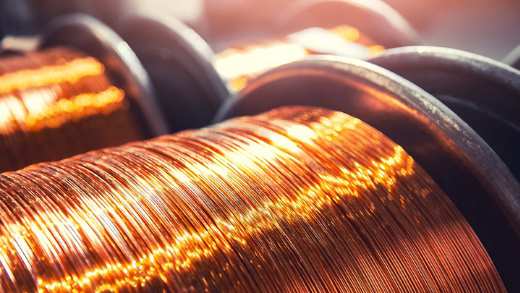Read this article to understand:
- The drivers of growth in semiconductors
- Headwinds facing the industry
- The key ESG implications
Semiconductor microchips play an important role in everyday life. They are an indispensable and ubiquitous component of the electric devices we use today – found in everything from the laptops on our desks to the smartphones in our pockets to the fridges in our kitchens. These tiny bundles of transistors form the backbone of our technological society.
In 1961, the first patent for a silicone-based integrated circuit was granted to American physicist Robert Noyce. It was a milestone for the digital economy. Since then, the semiconductor industry has grown dramatically. According to Statista, semiconductor sales have skyrocketed in the last three decades, reaching over $580 billion worldwide in 2022.1
Considering the extent to which semiconductors permeate our world, it is not surprising the industry accounts for a sizable chunk of global GDP. According to a report from the Semiconductor Industry Association (SIA), the sector directly contributed around $3 trillion to global GDP between 1995 and 2015, and an extra $11 trillion indirectly.3 A UK government report found that, as of 2020, revenue from semiconductor sales accounted for around 0.5 per cent of global GDP.4 The growth of generative artificial intelligence and cloud computing is set to give the sector a further boost.
Figure 1: Semiconductor sales worldwide, 1987-2022 (US$ billion)
Source: Statista, May 4, 2023.2
But it also faces headwinds. Supply-chain issues could prevent companies from meeting surging demand for semiconductors. And, as a strategically important industry, chipmaking is at the centre of a fierce geopolitical tussle. China and the US need to secure access to the most powerful chips – many of which are made in the threatened island nation of Taiwan.
In this article, we delve deeper into these dynamics and other key considerations for investors, including environmental, social and governance (ESG) risks.
The semiconductor ecosystem
The semiconductor industry is incredibly complex. It produces three main categories of chip – logic chips that process information; memory chips that store information; and DAO chips (discrete, analogue, and other), used in sensors and for other specific applications.5
The first semiconductor companies were vertically integrated and handled all aspects of production. But as chips have grown smaller, more powerful and sophisticated, they have become fiddlier and more expensive to design and make, driving companies to specialise.
This has led to a globe-spanning supply chain that connects different kinds of firms, from those focusing on chip design (such as Nvidia and Qualcomm) to foundries that manufacture chips (such as Taiwan Semiconductor Manufacturing Company, or TSMC) and many other companies involved in testing and assembly. While the US dominates in semiconductor research and development, Asia accounts for around 80 per cent of chip manufacturing.
The global supply chain is highly efficient; however, the industry also tends to be cyclical, partly due to chips’ relatively short lifespan. For instance, a spike in demand during the COVID-19 pandemic, due to a rise in the use of personal computers and other consumer electronics during lockdowns, led to shortages. But this was followed by a glut of certain types of chip when lockdowns ended and demand ebbed.7
Figure 2: The global journey of a smartphone application processor

Design
1. A European firm licenses IP on application processor architecture.
2. A US EDA firm provides highly sophisticated software for chip design.
3. A US fabless firm designs (and commercialises) the chip.
Commercialisation
4. The chip is selected (“designed in”) by a US smartphone OEM to power its new device.
Equipment
5. Highly advanced manufacturing equipment is developed by companies in the US, Japan and Europe, leveraging decades of global R&D efforts.
Materials
6. Silicon dioxide is mined in the US and refined into metallurgical grade silicon.
7. The silicon is melted and re-crystallized to form a large single crystal called an ingot by a polysilicon manufacturer in Japan.
8. The ingot is sliced into several wafers in South Korea, which are then polished and shipped to a fabrication plant.
Manufacturing
9. A foundry in Taiwan Imprints the wafers with an array of integrated circuits; “patterned” wafers are stacked and interconnected.
10. Individual chips are separated and packaged by an OSAT in Malaysia
Commercialisation
11. The chip is shipped to the smartphone OEM’s assembly partner in China, which incorporates it into a circuit board inside the phone.
12. The smartphone is sold to a consumer in the US.
Source: Boston Consulting Group, Semiconductor Industry Association, April 2021.6
Key growth drivers
Despite these fluctuations, the industry has seen enormous demand growth in recent years. But what about the long-term trajectory? Recent data by Precedence Research shows a positive trend, with the market poised to triple in value to almost $2 trillion by 2032.8
Figure 3: Semiconductor market size, 2022 to 2032 (US$ billion)
Source: Precedence Research, 20229
Consulting firm McKinsey identifies three main drivers of growth in the form of demand from automotive, data-storage and wireless industries. Taken together, these three areas are expected to drive 70 per cent of the semiconductor industry’s growth over the next decade.10
Modern cars are highly sophisticated electronic devices, containing between 1,400 and 1,500 chips on average
According to a survey conducted by KPMG, automotive is the most important revenue driver.11 At first, it might seem strange that car manufacturers are the main customers for semiconductor chips. But modern cars are highly sophisticated electronic devices, containing between 1,400 and 1,500 chips on average.13 Semiconductors are indispensable for a range of functions within vehicles, from battery management to powering electronics and driver assistance, making features like touchscreens, navigation and connectivity possible.
Meanwhile, faster wireless communication is also driving increasing usage. The roll-out of 5G technology and infrastructure necessitates the use of higher-performing chips with greater memory and storage capacity. And, in an era when text messages and emails are routinely backed up in the cloud, the best-performing chips are also required in servers to provide the necessary computing power.
Figure 4: Importance of application by revenue (1-5 scale)
Source: KPMG, February 2023.12
AI drives demand for high-end chips
Despite growth in other areas, another driver of semiconductor demand is dominating the headlines: artificial intelligence. While AI has been around for some time, the public release of Open AI’s ChatGPT platform in November 2022 heralded a new era in mass-market use of the technology and is expected to stoke further appetite for semiconductors.
There are different types of AI chip. Today, the main demand is for graphic processing units (GPUs), a type of logic chip, used to develop and refine AI algorithms. Demand for GPUs has surpassed more general-purpose chips like central processing units (CPUs).
Given the extreme processing power required for AI, having the most powerful and smallest chips is vital
“Rather than processing things largely sequentially, like CPUs do, GPUs can process multiple computations simultaneously,” explains Alistair Way, head of equities at Aviva Investors. “Given the extreme processing power required for AI, having the most powerful and smallest chips is vital. The semiconductor manufacturing companies that can operate at these linewidths are winning the race.”
The main GPU producers are Nvidia, AMD and Intel. However, Nvidia dominates, producing the world’s fastest GPU for AI applications, the Nvidia H-100, which gives the company incredible pricing power.
“Nvidia is currently making over $40,000 per card for the new H-100, with a gross margin of over 90 per cent, while its rivals are struggling to gain ground,” says Way.
Californian-based semiconductor company AMD is trying to catch up with Nvidia’s high-end chips with the launch of its rival MI300X GPU later this year, which has been designed to power the so-called large-language models that underpin AI.14
Nvidia’s share price had risen by over 240 per cent in the year to August 29, following the hype generated by ChatGPT. But the company does not manufacture its own chips, instead relying on Asian chip foundries, mainly TSMC. Together, these companies top the list of the largest semiconductor companies in the world by market capitalisation (Figure 5).
Figure 5: Largest semiconductor companies by market cap (US$ billions)
Source: Aviva Investors, CompaniesMarketcap.com. Data as of September 7, 2023.15
Nvidia was not the only stock to rise since the launch of ChatGPT last November – other AI-themed stocks did as well (see figure 6).
At first sight, the concentration of the market among the leading chipmakers suggests these companies will be the biggest winners from the AI boom. But can their growth be sustained?
Asian chipmakers have reported low earnings this year. For instance, TSMC announced its revenues are likely to be down ten per cent for 2023 due to weaker-than-expected Chinese demand for some of the more-common chip types. At the same time, the company is struggling to meet demand for higher-end chips used in AI technology.16 Some commentators suggest the supply shortage could weigh on Nvidia’s share price in future.17
Progress in AI is also reshaping the memory-chip market
Progress in AI is also reshaping the memory-chip market. While most memory chips are commoditised and used widely, AI needs a specific type of DRAM memory chip called high bandwidth memory (HBM), which can deal with more complex computational tasks at high speed. Increasing demand for HBM chips, which are used in the big Nvidia GPUs, has sparked a battle for market share between the world’s top two memory-chip makers, South Korea’s Samsung Electronics and SK Hynix.18
“HBM is a temporary storage memory that can process a large quantity of information very fast – a bit like the human brain – and is useful in training large-language models such as ChatGPT,” explains Way. “AI is accelerating the move towards high-end memory chips.”
Figure 6: Performance of AI-themed stocks (per cent)
Source: Statista, May 4, 2023.2
All that glitters is not gold
While cloud computing and AI represent thematic tailwinds, there are many risks associated with the semiconductor industry. Most obvious is the concentrated production of semiconductors. The top five producers are Taiwan, South Korea, Japan, US and China, but almost all high-end chips are manufactured in either Taiwan or Korea.19
Almost all high-end chips are manufactured in either Taiwan or Korea
Much of Taiwan’s dominance is attributed to a single company, TSMC, which runs the world’s largest foundry and has a 58 per cent market share of the global semiconductor foundry market.20
TSMC makes chips for other companies, including tech giants Apple and Qualcomm, which don’t have the capability to manufacture their own. Meanwhile, ongoing tensions between China and Taiwan, which it considers a renegade province, adds further complexity. The world is increasingly reliant for a key strategic resource on a single company in a country The Economist calls “the most dangerous place on Earth”.22
Figure 7: Leading semiconductor foundries revenue share worldwide, 2022 (per cent)
Source: Statista, May 4, 2023.2
“We depend so much on Taiwan. What if there is a conflict between China and Taiwan?” says Way. “The semiconductor shortage during the pandemic brought attention to the fragility of the modern industrial life and has made countries rethink ‘just-in-time’ supply chains. Countries are now looking to re-shore strategic industries, including chipmaking.”
This is the thinking behind the CHIPS and Science Act in the US and the European Union’s Chips Act, which represent politically motivated attempts to encourage semiconductor production away from Asia to build domestic capacity, reduce supply-chain risks and increase national security. But the process is slow.
In reality, it is difficult to incentivise new suppliers due to the enormous upfront investment needed to build foundries – it can cost up to $20 billion to build a chip factory from scratch. Location is also a key factor, as factories need plenty of space, proximity to water and electricity and a low risk of natural disasters.
Furthermore, the US semiconductor industry faces a significant shortage of skilled workers, which is hindering the growth of the domestic chips economy. TSMC has postponed to 2025 the start of production at a facility currently under construction in Arizona, citing a lack of skilled staff.23 No wonder, when it reportedly takes eight years to train an engineer of basic capability to work in one of TSMC’s Taiwanese facilities.24
According to a new study by the SIA, the US semiconductor industry’s workforce is projected to grow by nearly 115,000 to approximately 460,000 by the end of the decade, but an estimated 67,000 of those roles might go unfilled because of a shortfall in skilled technicians, scientists and engineers.25
A thirsty and ‘brutal’ business
On top of geopolitical and supply-chain vulnerabilities, there are also significant ESG risks.
The chip industry is energy intensive, with a massive carbon footprint. By way of context, the large semiconductor fabrication plants can consume 100 megawatts of electricity per hour – enough to power 50,000 houses, according to McKinsey.26
Semiconductor companies have generally been behind the curve in terms of setting emissions reduction targets
“Companies in the semiconductor industry have generally been behind the curve in terms of setting emissions reduction targets in line with the Paris Agreement,” says Louise Piffaut, head of ESG equity integration at Aviva Investors.
Semiconductor manufacturing is a complex process that includes cleaning the wafers in a closed environment where the air is replaced by gas. “In the past, this was done with perfluorocarbons, which are highly potent gases. These gases have now been replaced by nitrogen trifluoride, which is more efficient but also 17,000 times more potent than carbon dioxide as a global warming agent,” explains Piffaut.
But the main issue remains water use. Producing a microchip requires an incredible amount of water, and not just any type of water will do. Chips need to be cleaned by ultra-pure water (UPW). According to the American Bar Association, one chip might require as much as 2,200 gallons of UPW.27 This is causing massive water scarcity in Taiwan and could create similar issues in Arizona, where TSMC’s new factories are being built.
“The semiconductor manufacturing process requires robust water management and reuse programmes, particularly when facilities are located in areas of high water stress,” says Piffaut.
According to our own research, two companies that have a high percentage of operations in high water stress locations are TSMC and Micron. However, TSMC notably has one of the highest water recycling rates in the market and lower water withdrawal intensity than its peers.
Meanwhile, Taiwan is facing the worst drought in a century.28 This has forced its government to intervene and pay farmers not to grow rice, to allow semiconductor plants to have the water they need. This will exacerbate other environmental risks, as dry conditions are associated with a rise in pest species. Despite these efforts, and TSMC’s commitment to use reclaimed water, many of Taiwan’s reservoirs are less than half full.29
The demand for technology and electronic products has increased the strain on companies and their suppliers
Finally, the semiconductor industry is considered high risk in terms of human rights, with the most salient risks related to the manufacture of components. “The demand for technology and electronic products has increased the strain on companies and their suppliers, and in turn on their workforces, resulting in long overtime,” says Piffaut.
For instance, TSMC has attracted controversy for its treatment of employees. Recently, chairman Mark Liu responded to criticism of its workplace culture in a bullish fashion, saying: "Those who are unwilling to take shifts should not enter the industry.”30
As companies in this sector often source from countries with high migrant populations and poor worker protections, the risks of forced labour are particularly high. The sourcing of raw materials is also associated with mining activity, known for its use of forced and child labour and unsafe working conditions.
“Whilst audits are an important part of human rights due diligence, they are not sufficient on their own, as they identify things that have already gone wrong. We prefer the approach of doing a due-diligence exercise to identify what salient risks the company is facing through its value chain to manage them,” says Piffaut.
Investment implications
Despite these issues, the industry continues to attract significant investment – and not just in chipmakers. Way cites opportunities in companies that supply equipment to major semiconductor manufacturers, such as Dutch multinationals ASML and ASM International.
“Companies in this niche are doing well and demand for their equipment could accelerate dramatically as a consequence of AI,” he says.
Companies in this niche are doing well and demand for their equipment could accelerate dramatically
ASML is the only firm that makes extreme ultraviolet lithography machines, used to create the smallest, most sophisticated chips. Chinese companies spent $2.58 billion on these machines in the first half of 2023, as part of a record outlay on chipmaking equipment.31 In total, China imported $5 billion worth of semiconductor tools in June and July, up from $2.9 billion during the same period a year earlier.32
But it is important to note this increased investment is occurring against a backdrop of political uncertainty. Part of the reason for China’s splurge is that it was building a stockpile before export restrictions on sales of chipmaking equipment came into force around the world, as part of a US-led effort to limit the Asian power’s access to critical parts. The Netherlands imposed its own restrictions on September 1, including a requirement that buyers of key semiconductor tools obtain a license from the Dutch government.33
This example neatly illustrates both the opportunities and the risks of participating in such a vast and globally vital industry. In an increasingly tech-driven world, demand for high-end semiconductors is likely to keep on rising. But with geopolitical hazards, supply-chain issues and ESG controversies to consider, company selection is crucially important. Or to put it another way, investors must think carefully before betting on chips.


















